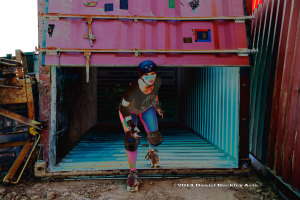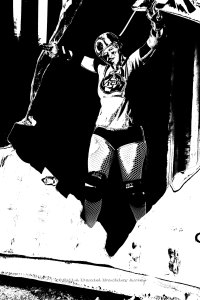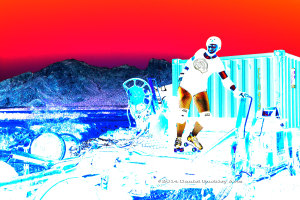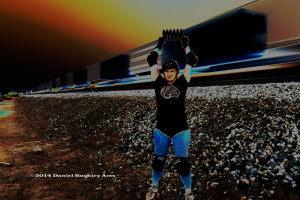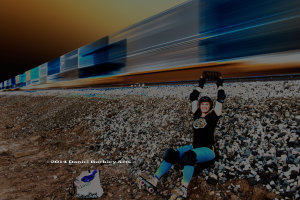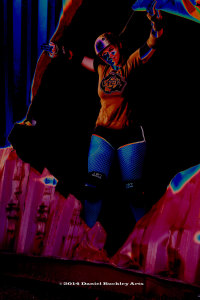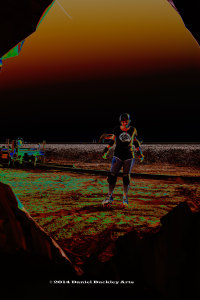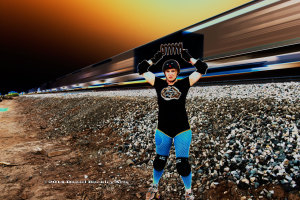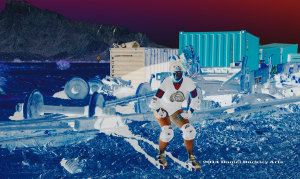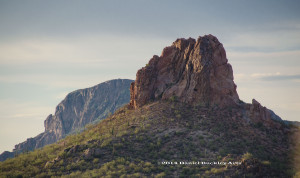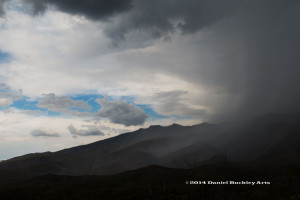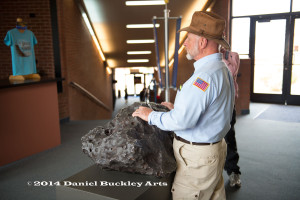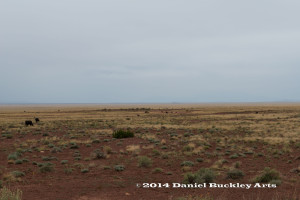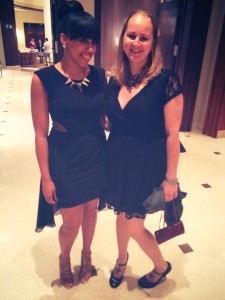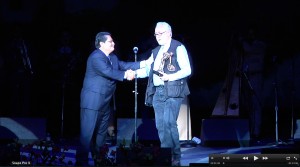
Tucson International Mariachi Conference president Alfonso Dancil inducts Daniel Buckley into the Mariachi Hall of Fame at the 2013 Espectacular Concert.
I was recently asked by one of the members of Harvard’s Mariachi Véritas, Tony Liu, how mariachis had become such a passion in my life.
It is an odd thing, I suppose. I am an Irish Catholic boy from the Hudson Valley of New York State. But mariachis have kept coming up in my life since I arrived in Tucson in 1971 to study the geology of the moon at the University of Arizona. I saw my first mariachis during my freshman year of college and dug the sound straight off. Only later though would it become a powerful part of my life.
I’ll get back to that, but there are some pivotal points, and the path is convoluted. One was in the 1980s when I dated a woman who was doing her residency to become a medical doctor. Her dream was to go to Africa and help people there, and for me to be with her and collect field recordings of African music in remote locations. I liked the idea. African music had long been a point of high interest to me. It’s the root of so much that is truly American music, from jazz and blues to gospel, soul, spirituals, zydeco and so much more. There would be no rock and roll without it, and what makes American classical music what it is often references that African underpinning.
In fact classical music is what started my interest in global music to begin with. As I developed my ear, I could always hear something special about performances of symphonic music by conductors from the country of the composer. In a personal way they understood the folk roots and indigenous rhythms those composers called upon and infused their performances with the aural embodiment of that knowledge.
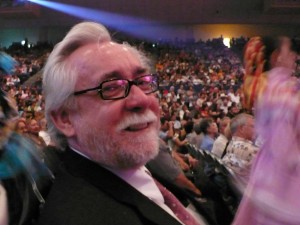
Daniel Buckley in the audience
Over time, my thirst for the roots music of the globe became as deep as my curiosity about classical music from around the world and across time. The deeper I got into both, the more I came to understand the secrets locked in all regional music. The music of a given place, particularly its folk music, holds information about how isolated that area was over the long term, who it traded with, who it had wars with and what it held sacred. Years later I would get to meet Alan Lomax of the Library of Congress, who’s dad – John Lomax – had made the first recordings for the that institution. Lomax came up with a system of clues one could discern from vocal folk music that would tell you all kinds of things about that culture’s past. He called it Cantometrics, and I spent one summer studying his tapes to get a modest grasp of the technique.
But getting back to my doctor girlfriend in the early 1980s, the idea was growing in me to jump ship, move to Africa with or without her, buy a good field recorder and get busy recording things halfway around the world. And then one weekend something happened that spun me around. I can’t recall the circumstances but somehow in that three day weekend I was taken to see a waila band, a mariachi and a norteño band. Mariachi most people know. Norteño (aka conjunto) is the music of northern Mexico along the U.S. border that features accordions and bajo sextos and a nasal vocal style. The Tohono O’odham tribe of Arizona and northern Mexico then adapted norteño to their own tastes, turning it into a strictly instrumental form of social dance music called waila (from the Spanish baile – dance) for dances that went on from sundown to sunrise in the Sonoran desert.
After that weekend I realized the world was all around me right where I was. The mariachi clearly had roots in Mexico’s indigenous cultures, its Spanish history as well as music brought by African slaves. That was fascinating. Similarly norteño was a multi-cultural mix that borrowed accordions dance forms from Eastern Europeans (Czechs, Poles and Germans) who settled on both sides of the U.S./Mexico border. And Waila gave it that regional Native American flavor. I would later discover that Pascua Yaqui and other tribes along the border would add their own stamp to these regional musical forms as well. But the point is, I realized I didn’t have to travel anywhere to find something that was underexplored and fascinating as hell. It was right here in Tucson, Arizona. And as you may have figured, the girl and I broke up long before decisions about a trip to Africa needed to be made.
In 1987 I went to work for the Tucson Citizen – a daily newspaper that had been around since 1870 – as a music critic. And while my main beat was writing about the classical music institutions (the opera, symphony and chamber music groups), I couldn’t resist writing as well about mariachis, waila bands and norteño groups. Not long after I came to the paper the first Norteño Festival debuted, and soon after that the Waila Festival. Both are now gone but each lasted at least a decade and gave Tucson a real musical education about cultures right under our noses. The Tucson International Mariachi Conference had been going for a couple of years when I joined the Citizen staff, and I made a point of going to cover it my first year.
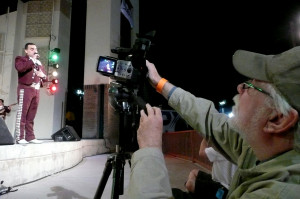
Shooting Mariachi Los Arrieros from El Paso, Texas.
Mind you, I will be the first to admit that while I was highly interested in these art forms I was as clueless as I could be. There weren’t books on these subjects back in those days and you grabbed recordings wherever you could. But I was very lucky to make the acquaintance of four people who would patiently guide me in my early days of sheer ignorance and folly and try to help me come to a more complete understanding. That quartet includes Raul Aguirre, Julie Gallego, Angelo Joaquin, Jr. and Elva Flores. Aguirre was an up and coming Latino advertising genius who had been a former DJ on Spanish radio and knew just about everything there was to know about any type of Latino music. Julie Gallego was a Mexican folklórico choreographer and educator who would become one of the most original producers in that field. Elva Flores was one of the founders of the mariachi conference, the founder of El Centro Cultural de las Americas, and an expert on many aspects of Mexican culture. And Angelo Joaquin, Jr. was the son of one of the pioneers of modern waila music, and the creator of the Waila Festival. Later Richard Carranza, founder of Pueblo High School’s Mariachi Aztlán and now superintendent of schools in San Francisco, would become one of my mariachi mentors.
All of them had a stake in knowing someone at the newspaper who was interested in what they did, and all were incredibly resourceful at setting me up with other contacts who could help me fill in the gaps along the way. And they were kind enough to set me straight when I made mistakes.
As I mentioned, both the waila festival and the norteño festival died out after a period of time, and so I had less occasion to write about these genres. The mariachis, by contrast, came to thrive in my 22 years with the paper. Propelled by Linda Ronstadt’s “Canciones de Mi Padre” and “Mas Canciones” CDs of the late 1980s, and reinforced by a burgeoning mariachi and folklórico education movement in the schools, mariachis became a cultural force in the Tucson community. The Tucson International Mariachi Conference had to extend its Espectacular concerts to two nights during the heyday, and even then tickets sold out months in advance.
As someone from a classical background I was very comfortable with the mariachis. In essence the show groups were chamber opera companies, packed with instrumental virtuosos and vocalists of every color. But like norteño and waila, they also tread upon the popular music traditions. The music drew as much from popular Mexican cinema as it did from the regional “sones” – the roots music of the mariachi. Pre 20th century classical music was such a hodgepodge as well, incorporating regional roots music and popular music of the day. So the mariachis resonated with me on many levels.
Year after year I covered the mariachi world more and more, first as a writer and later filming it during my days as the multimedia manager for the Citizen. I reviewed the Espectacular concerts each year and wrote in depth about the conference workshops, participant showcases and Garibaldi showcases. I had to write about the various intrigues as well over the years.
But as the decades progressed and my knowledge increased, I began to see the important larger trends that were going on. I started to recognize individual kids and see them evolve into budding mariachis, and so much more. Because I live just a few blocks from the University of Arizona, and have taken classes at Pima College, I began seeing young mariachi and folklorico students in college in larger numbers. This was a significant change from when I was in college in the early 1970s when much fewer Mexican Americans were in classrooms with me than the population would have suggested. Mariachi scholarships and the need to keep grades high to stay in mariachi and folklorico programs was visibly making a difference. I started writing about this for the Citizen in the years just before Gannett Newspapers closed it down for good.
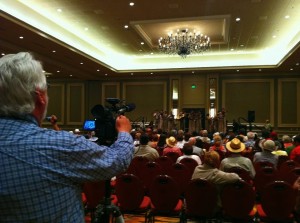
Shooting youth mariachis is 2012
When the paper closed I started doing documentary films about Hispanic culture and history in Tucson. My five year plan was to have the skills and knowhow in place by 2014 to be ready to tackle the story of how these youth programs were making a difference in time to document the 50th anniversary of the youth group that started it all – Tucson’s Mariachi Los Changuitos Feos (the ugly little monkeys). As I work on this film, titled “The Mariachi Miracle,” I am discovering that the topic is so large it will still take me into early 2016 to get the story wrapped.
I’ll be the first to admit that I love doing this – not just telling the story but seeing the music progress in my community as well. Year after year I am blown away at student performances at the high degree of musicality being achieved at younger and younger ages. I love seeing individual kids progress year after year, watching them go on to become professionals in the community, teachers and even mariachi instructors. It’s a joy to watch young musicians who will likely become the next Mariachi Cobre or Linda Ronstadt, taking Tucson’s name to the rest of the country and the world. More than that I see what it has done in making our city a better place to live for everyone.
In the 50 years since the Changuitos started, Mexican Americans have gone from being treated as a source of community embarrassment in the era of urban renewal to being a source of civic pride in our historic place. The mariachi and folklorico dancer have become as much symbols of the city as the iconic saguaro cactus. Moreover, graduates of mariachi and folklorico programs have learned key skills – teamwork, discipline, self confidence, pride and the ability to speak in front of any group of people – that are giving them an edge in the competitive job marketplace. They are socially dressed for success, and are taking their place among the leaders of our city and state as politicians, doctors, lawyers, engineers, teachers and, well, mariachis too. They are sought out for their musicianship, not just in the mariachi world but in opera and classical music, as well as many other genres. So why did I become such a fanatic about mariachi music? Part of it is the intoxicating power of the music itself – so expressive, so powerful, so dreamy. And part of it is seeing what this music is doing, not just in my city but around the United States and the world. It is more than just music now. It is a force of change.
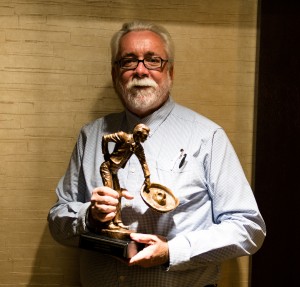
Documentary filmmaker Daniel Buckley.
I still love all the other things I loved before. All the tangled musical roots that keep Tucson so vibrant. But the music and dance of mariachi culture holds a special place in my heart. It has changed me as surely as it has changed my city. And I like what it has made me.
Posted in Cine Plaza progress, Daniel Buckley Arts, Daniel Buckley Documentaries, Mariachi documentary, Slice of Life, Uncategorized
Tags: Africa, Angelo Joaquin Jr., conjunto, Daniel Buckley, documentary, Elva Flores, folklorico, Harvard, Julie Gallego, Linda Ronstadt, mariachi, Mariachi Cobre, Mariachi Veritas, norteno, Raul Aguirre, Richard Carranza, The Mariachi Miracle, Tohono O'odham, Tucson International Mariachi Conference, waila, world music



